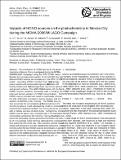Impacts of HONO sources on the photochemistry in Mexico City during the MCMA-2006/MILAGO Campaign
Author(s)
Li, Guohui; Lei, Wenfang; Zavala, R.; Volkamer, R.; Dusanter, S.; Stevens, P.; Molina, Luisa Tan; ... Show more Show less
DownloadLi-2010-Impacts of HONO sources on the photochemistry.pdf (3.990Mb)
PUBLISHER_CC
Publisher with Creative Commons License
Creative Commons Attribution
Terms of use
Metadata
Show full item recordAbstract
The contribution of HONO sources to the photochemistry in Mexico City is investigated during the MCMA-2006/MILAGO Campaign using the WRF-CHEM model. Besides the homogeneous reaction of NO with OH, four additional HONO sources are considered in the WRF-CHEM model: secondary HONO formation from NO2 heterogeneous reaction with semivolatile organics, NO2 reaction with freshly emitted soot, NO2 heterogeneous reaction on aerosol and ground surfaces. The WRF-CHEM model with the five HONO sources performs reasonably well in tracking the observed diurnal variation of HONO concentrations. The HONO sources included are found to significantly improve the HOx (OH+HO2) simulations during daytime and the partition of NO/NO2 in the morning. The HONO sources also accelerate the accumulation of O3 concentrations in the morning by about 2 h and subsequently result in a noticeable enhancement of O3 concentrations over the course of the day with a midday average of about 6 ppb. Furthermore, these HONO sources play a very important role in the formation of secondary aerosols in the morning. They substantially enhance the secondary organic aerosol concentrations by a factor of 2 on average in the morning, although they contribute less during the rest of the day. The simulated particle-phase nitrate and ammonium are also substantially enhanced in the morning when the four HONO sources are included, in good agreement with the measurements. The impact of the HONO sources on the sulfate aerosols is negligible because of the inefficient conversion of H2SO4 from SO2 reacting with OH.
Date issued
2010-07Department
Massachusetts Institute of Technology. Department of Earth, Atmospheric, and Planetary SciencesJournal
Atmospheric Chemistry and Physics
Publisher
Copernicus Publications on behalf of the European Geosciences Union
Citation
Li, G. et al. “Impacts of HONO Sources on the Photochemistry in Mexico City During the MCMA-2006/MILAGO Campaign.” Atmospheric Chemistry and Physics 10.14 (2010) : 6551-6567.
Version: Final published version
ISSN
1680-7324
1680-7316